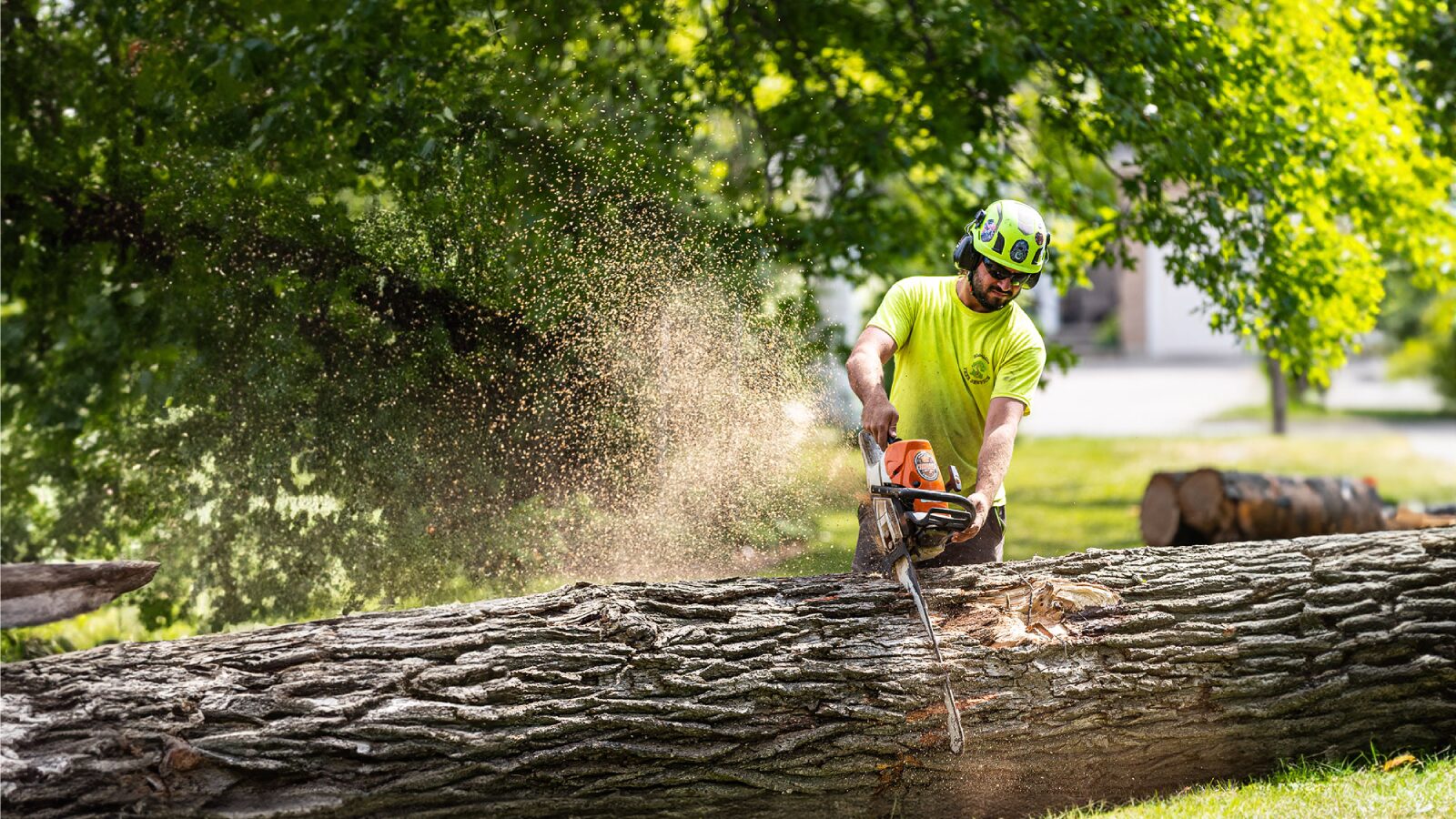1. Cracks or Splits in the Trunk or Limbs
If you spot a deep split or crack in the trunk or one of the main branches, don’t ignore it. Trees can crack from storm pressure, wind, or simply from age and stress. These fractures weaken the structure, making it more likely to break and fall.
Sometimes the damage is hidden on the backside of a tree or near a limb connection. That’s where decay and fungi like to hide. If the crack is vertical and deep, it can signal a major internal issue.
Pro Tip: Trees with open wounds are more likely to attract pests and decay fungi.
2. A Leaning Tree—Especially If It’s Sudden
Some trees naturally lean, especially if they grew toward the sunlight. But if you notice a new lean—or if the tilt has suddenly become more severe—your tree may be losing its grip underground.
In Florida, our soft sandy soil and heavy rainfall make it easy for roots to shift or rot. This makes the whole tree unstable, especially during storms or hurricanes.
Look for heaving soil, exposed roots, or cracks in the ground around the base. These are early warnings that the tree is preparing to fall.
3. Dead or Falling Branches
Dead branches don’t just look bad—they’re dangerous. They can fall without warning, especially when dry or during a windy day. You’ll often see them hanging in the canopy or lying on the ground after a small breeze.
These branches are often called “widowmakers” for a reason. If they fall on someone or your roof, the damage can be serious.
Regular tree trimming helps prevent this. It also keeps the tree healthier by redirecting nutrients to the living parts.

4. Fungal Growth Around the Base
Mushrooms or fungus growing at the base of your tree are often a sign of root rot or internal decay. These organisms feed on dead wood, so if they’re growing, something inside your tree may already be dying.
One common culprit in Florida is Ganoderma, a type of shelf fungus that feeds on the heartwood and weakens the entire structure.
Also watch out for soft or spongy bark, foul smells, or oozing sap—these are signs of infection or decay deep inside.
5. Sparse Leaves or Early Leaf Drop
A healthy tree should have a full, green canopy in the right season. If yours has thin leaves, patchy growth, or starts dropping leaves too early, it may be in distress.
This could be due to pests, disease, poor soil, or water stress. In some cases, internal decay prevents nutrients from reaching the branches. You may also see brown edges on leaves, curled tips, or unusual spotting.
Keep an eye on surrounding trees too—some diseases spread quickly from one tree to another.
6. Exposed or Damaged Roots
Roots are the lifeline of any tree. If you see them poking above the soil, cracked, or broken, it’s time to act. Construction, heavy foot traffic, and erosion can damage roots. So can rot from overwatering or poor drainage.
In Ruskin, we often see root damage from sidewalk lifting, driveway cracking, or roots wrapping around themselves (called girdling roots).
Installing a root barrier or improving drainage can help protect your property and the tree’s health.
7. Hollow or Cavities in the Trunk
A tree doesn’t need to be completely solid to stand tall—but when large cavities or hollows form, especially near the base, the structural strength is compromised.
Woodpecker activity, internal decay, and fungi often go hand in hand here. You might hear a “hollow” sound when you knock on the trunk.
This kind of damage needs an expert eye to determine if removal is necessary or if the tree can be braced safely.
Why These Signs Matter More in Ruskin’s Climate
Living in Ruskin means living with tropical storms, heavy rain, and intense humidity. That kind of weather wears down trees faster than in other parts of the country. Soft soil can shift easily. Salt air can dry out certain species. Add in pests like borers or bark beetles, and you’ve got a recipe for tree failure.
Many of our local trees—like live oaks, palms, and mangroves—have their own unique care needs. Ignoring small issues can lead to major damage when the next storm hits.
What You Should Do Next
If you notice any of the signs above, don’t wait. Reach out to a certified arborist who knows Florida trees and laws. Some cities even require permits before removing trees—especially mangroves or protected species.
Panorama Tree Care offers free quotes, detailed inspections, and honest recommendations with no pressure. Our team is trained to handle tree risk assessments, pruning, removals, and emergency calls.
They’ve been serving the Tampa Bay and Ruskin area for over 24 years.
👉 Check out our full services for tree service Ruskin FL if you’re worried about a tree on your property.
How to Keep Your Trees Healthy Year-Round
- Trim every 1-2 years to shape and strengthen the canopy
- Fertilize in spring and fall for optimal growth
- Inspect after storms for cracks, lean, or broken limbs
- Remove moss and dead branches to prevent decay
- Consider root barriers if you notice sidewalk damage or shallow roots
It doesn’t take much to keep your trees strong—but it does take attention. Prevention is cheaper than emergency removal, and a healthy tree can last for generations.
Final Thought
Trees may be silent, but they’re always sending signals. You just have to know how to listen. Spotting the signs early could save your home, your safety, and thousands in repairs.
If you’re unsure about a tree on your property, don’t guess. Call in a pro and get peace of mind.
